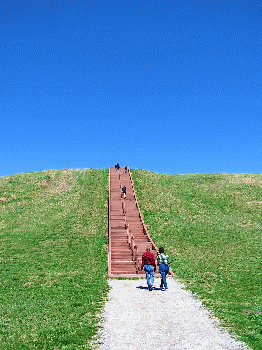I am standing atop a 100-foot-high Temple Mound, the largest known earthwork in the Americas built by prehistoric peoples. The temperatures, in the high 80s, along with the oppressive humidity, have emptied the park of all but a handful of visitors. My shirt is matted with sweat.
I look out from the structure known as Monks Mound at the flatlands below, with smaller mounds dotting the distance. These earthen mounds, built at a confluence of the Illinois, Mississippi, and Missouri rivers, are all that remain of one of the largest pre-Columbian settlements north of Mexico, occupied from around 800 to 1,400 AD, by perhaps as many as 20,000 people.
This great city, perhaps the greatest in North America at the time, rose, flourished, fell, into decline, and was ultimately abandoned. Civilizations die in familiar patterns. They exhaust natural resources.
They spawn parasitic elites who plunder and loot the institutions and systems that make a complex society possible. They engage in futile and self-defeating wars. And then the rot sets in.
The great urban centers die first, falling into irreversible decay. Central authority unravels. Artistic expression and intellectual inquiry are replaced by a new dark age, the triumph of tawdry spectacle, and the celebration of crowd-pleasing imbecility.
"Collapse occurs, and can only occur, in a power vacuum," anthropologist Joseph Tainter - writes in 'The Collapse of Complex Societies' - "Collapse is possible only where there is no competitor strong enough to fill the political vacuum of disintegration."
Several centuries ago, the rulers of this vast city complex, which covered some 4,000 acres, including a 40-acre central plaza, stood where I stood. They no doubt saw below in the teeming settlements an unassailable power, with at least 120 temple mounds used as residences, sacred ceremonial sites, tombs, meeting centers, and ball courts.
Cahokia warriors dominated a vast territory from which they exacted tribute to enrich the ruling class of this highly stratified society. Reading the heavens, these mound builders constructed several circular astronomical observatories, wooden versions of Stonehenge.
The city's hereditary rulers were venerated in life and death. A half mile from Monks Mound is the seven-foot-high Mound 72, in which archeologists found the remains of a man on a platform covered with 20,000 conch-shell disc beads from the Gulf of Mexico.
The beads were arranged in the shape of a falcon, with the falcon's head beneath and beside the man's head. Its wings and tail were placed underneath the man's arms and legs. Below this layer of shells was the body of another man, buried face downward. Around these two men were six more human remains, possibly retainers, who may have been put to death to accompany the entombed man in the afterlife.
Nearby were buried the remains of 53 girls and women ranging in age from 15 to 30, laid out in rows in two layers separated by matting. They appeared to have been strangled to death.
The poet Paul Vale'ry noted, "a civilization has the same fragility as a life."
Across the Mississippi River from Monks Mound, the city skyline of St. Louis is visible. It is hard not to see our own collapse in that of Cahokia. In 1950, St. Louis was the eighth-largest city in the United States, with a population of 856,796. Today, that number has fallen to below 300,000, a drop of some 65 percent. Major employers, Anheuser-Busch, McDonnell-Douglas, TWA, Southwestern Bell, and Ralston Purina, have dramatically reduced their presence or left altogether. St. Louis is consistently ranked one of the most dangerous cities in the country. One in five people live in poverty.
The St. Louis Metropolitan Police Department has the highest rate of police killings per capita, of the 100 largest police departments in the nation, according to a 2021 report. Prisoners in the city's squalid jails, where 47 people died in custody between 2009 and 2019, complain of water being shut off from their cells for hours, and guards routinely pepper spraying inmates, including those on suicide watch.
(Note: You can view every article as one long page if you sign up as an Advocate Member, or higher).






